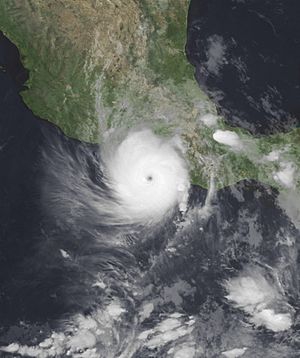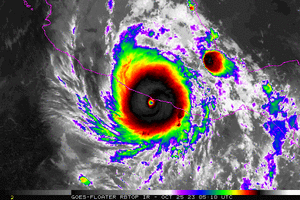Hurricane Otis facts for kids

Otis near peak intensity off the coast of Guerrero early on October 25
|
|
| Meteorological history | |
|---|---|
| Formed | October 22, 2023 |
| Dissipated | October 25, 2023 |
| Category 5 tropical cyclone | |
| 1-minute sustained (SSHWS/NWS) | |
| Highest winds | 165 mph (270 km/h) |
| Lowest pressure | 923 mbar (hPa); 27.26 inHg |
| Overall effects | |
| Fatalities | ≥43 confirmed |
| Missing | ≥10 |
| Damage | Unknown |
| Areas affected | Southern Mexico |
|
Part of the 2023 Pacific hurricane season |
|
Hurricane Otis was a very strong and fast-growing tropical cyclone. It hit land in October 2023 near Acapulco, Mexico. Otis was a Category 5 hurricane when it made landfall. This means it was incredibly powerful.
Otis was the first Pacific hurricane ever to hit land as a Category 5 storm. It was even stronger than Hurricane Patricia, which was the previous record holder. Otis was the fifteenth tropical storm and second Category 5 hurricane of the 2023 Pacific hurricane season.
The storm started as a small weather disturbance far out in the ocean. Experts first thought it would only be a weak tropical storm. But Otis quickly grew much stronger in a process called explosive intensification. Its winds reached about 165 mph (270 km/h). It hit land at its strongest point. After moving inland, the hurricane quickly lost power and disappeared the next day.
When Otis hit Acapulco, its strong winds caused a lot of damage. Many buildings were badly hurt. There were also landslides and flooding from heavy rain. Communication was cut off, so it was hard to know what was happening at first. Many radio stations were also damaged. After the storm, Acapulco had no drinking water, and many homes lost electricity. The government sent thousands of military members to help people and clean up. At least 43 people died, and at least 10 people were missing.
Why Was Otis So Strong?
Hurricane Otis became much stronger than anyone expected. Its path and strength were very different from what weather experts had predicted. When Otis first formed, forecasts did not even show it hitting land. They thought it would curve away as a weak tropical storm.
Just 24 hours before Otis became a Category 5 hurricane, experts thought its strongest winds would only be about 70 mph (110 km/h). Even 16 hours before it hit land, they predicted it would be a weaker Category 1 hurricane. They also thought it would hit land much later than it actually did.
Weather computer models could not predict how fast Otis would grow. This was partly because there was not enough data. Only one special "Hurricane Hunters" plane flew into the storm. Also, there is no Doppler weather radar in the area where it hit. Some models did not even show the storm hitting land at all. Experts like Michael Brennan, who leads the National Hurricane Center, said there are very few tools like ocean buoys or radar to measure hurricane strength in the East Pacific. This means forecasters rely mostly on satellite images.
Impact of the Hurricane
Hurricane Otis hit Acapulco as a Category 5 hurricane on October 25. It was by far the strongest hurricane to ever hit this part of Mexico. A weather station on Isla de La Roqueta near Acapulco recorded a wind gust of 135 mph (217 km/h). This happened as the strongest part of the storm, called the eyewall, moved over the city.
Across the state of Guerrero, many power lines and electrical stations were damaged. This caused more than 500,000 homes to lose power. However, electricity was quickly restored to many homes. More than 220,000 homes in the state were damaged. Experts believe Otis caused billions of dollars in damage. Some even say it might be Mexico's most expensive weather disaster ever. Tourism officials called Otis the worst hurricane to hit Acapulco. They said it was even worse than Hurricane Pauline and Hurricane Manuel.
About 80% of all hotels in Acapulco were damaged. Many had flooding and collapsed ceilings. Several other buildings were also badly damaged or fell down. Eighteen radio stations in Acapulco stopped working, and communication was cut off. The city also lost access to drinking water. A shopping center was destroyed, and a part of a highway was closed because of a landslide.
Several airlines were affected by Otis. Flights to and from Acapulco International Airport were stopped. The airport itself was closed and hard to reach. The Pie de la Cuesta Air Force Base near Acapulco was also damaged. This made it harder for rescue teams to operate.
Otis also affected the earthquake warning systems in Mexico. A big part of the seismic network in Guerrero went offline. This network, called the SASMEX Network, sends out alerts through public speakers and radio. Twenty-seven sensors were affected in Guerrero and nearby states. Two broadcast towers were also damaged. This made it harder to warn major cities if an earthquake happened. By September 28, many of these sensors had been fixed.
See also
 In Spanish: Huracán Otis para niños
In Spanish: Huracán Otis para niños
- Weather of 2023
- Tropical cyclones in 2023
- List of Category 5 Pacific hurricanes
- Hurricane Bridget (1971) – a strong hurricane that hit Acapulco.
- Hurricane Pauline (1997) – another powerful hurricane that greatly affected Acapulco.
- Hurricane Manuel (2013) – a very damaging hurricane that caused a lot of harm in Acapulco.


